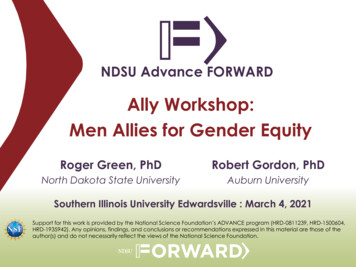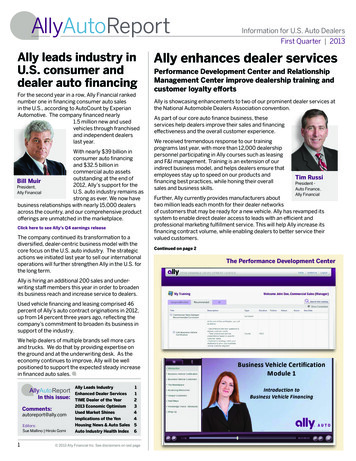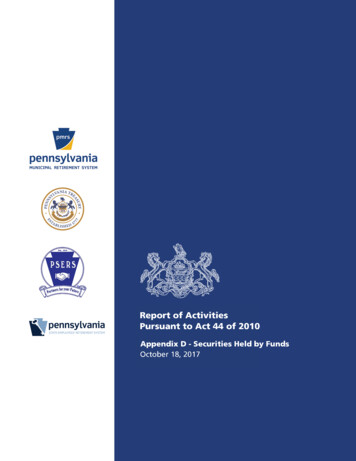
Transcription
NDSU Advance FORWARDAlly Workshop:Men Allies for Gender EquityRoger Green, PhDRobert Gordon, PhDNorth Dakota State UniversityAuburn UniversitySouthern Illinois University Edwardsville : March 4, 2021Support for this work is provided by the National Science Foundation’s ADVANCE program (HRD-0811239, HRD-1500604,HRD-1935942). Any opinions, findings, and conclusions or recommendations expressed in this material are those of theauthor(s) and do not necessarily reflect the views of the National Science Foundation.
A Little Bit About UsRoger: Elec. & Comp. Eng.Rob: PsychologyLong-time Advocates working with 30 institutions and 1000 menTwo Requests:1) No audio/video recording, 2) “Vegas” rulesOutline Context & background What the literature tells us Advocates & Allies, individual actions2
3
Some Preliminaries All men aren’t the same, and intersectionalities(race, ethnicity, etc.) should be considered Men are more likely to be skeptical aboutresearch that shows that gender bias exists(Handley et al., 2015; Flaherty, 2015) There are effective strategies to address thetypes of resistance common to change efforts(Moody, 2011)4
Why Focus on Men? Women are tired of educating men ongender-equity issues Women are tired of having primeresponsibility to fix gender-equity issues Women like the idea of men workingwith other men but want accountabilityand transparency Involving men, a group that is nottraditionally or fully involved in genderequity, expands the capacity fororganizational change
Equity vs. Equality (UNESCO)Gender Equality does not mean thatwomen and men have to become thesame, but that their rights, responsibilities,and opportunities will not depend onwhether they are men or womenGender Equity means fairness of treatmentfor women and men according to theirrespective needsEquity is a means for the goal of equality
7
8
Southern Illinois University Edwardsville:Context and Gender Equity EffortsInstitutional MemberNational Center for Faculty Development and Diversity (NCFDD)NSF ADVANCE Immersive Meaningful Practices for AccountableCampus Transformation (IMPACT) Fellows: EquityAdvisors Dual Career Support Initiative Senior Academic Leader Initiatives Equity Scorecards Promotion and Tenure Committee Training Support and Leadership Development Opportunities forMid-Career Women9
Data & ContextA snapshot of SIUE data that is consistent withnational trends and highlights:RetentionRecruitmentAdvancementClimate
SIUE Recruitment Perceptions
Why Does SIUE Need Advocates?Challenges in RetentionSIUE has challenges retaining female faculty:Faculty Retention by Rank by GenderMale Associate Prof,86%Female AssociateProf, 93%Male Assistant Prof,77%Female Assistant Prof,63%0%10%20%30%40%50%60%70%80%90%100%
SIUE Retention: Assistant ProfessorAssistant Professor Retentionby Gender by Race/EthnicityTotal hired0%Male Person of Color, 78%23Male White, 77%52Female Person of Color, 65%31Female White, 62%6120%40%60%80%100%
2020 Faculty Ranks by Gender
2020 Faculty Gender Distributionand SalariesSTEMSBSNon-STEMSBS
5 Year Trends: FacultyRepresentation
5 Year Trends: Faculty Pay Equity
Why Does SIUE Need Advocates?2020 Disparities in LeadershipFew women in leadership positions in 2020: Of the 9 academic deans, only 3 deans (33.3%)are women (Education, Nursing, and Library),one of which is a person of color There are a total of 39 department chairs and 14are women (35.9%) In the STEMSBS colleges, only 5 of 19 (26.3%)department chairs/heads are women In non-STEMSBS colleges, only 9 of the 20 (45%)department chairs/heads are women
Chilly Climate Research indicates a chilly climate towardwomen in many organizations What do we mean by climate?“A range of informal practices and implicitpolicies which, despite their relative subtletyand the fact that they do not intend to beharmful, do systematically disadvantagewomen relative to men” (Wylie, 1995)
Why DoesSIUE NeedAdvocates?ClimateChallenges2020 Annual Climate Survey N 340 respondents of661 faculty invited (55.3% respondentswere women)
SIUE Climate Survey Examples Engineering: 64% of male faculty and 50% ofwomen faculty agreed that their departmentcreates a healthy climate for all faculty Arts and Sciences: 81% of male faculty and55% of women faculty agreed that theirdepartment creates a healthy climate forwomen of color Education, Health and Human Behavior:100% of male faculty and 50% of femalefaculty agreed that their department createsa healthy climate for international women
22
Why Do Organizations Need Men Allies? When an organization is dominated by onegroup, that group is often unaware of theways in which the climate is set up to servethat group and disadvantage other groups When organizations are male-dominated,men can play an important role in creating amore inclusive and equitable climate Bottom-up approaches like Allies Programsare as important as top-down approaches Leverage knowledge & methods of racial,disability, & other social justice causes
24
Unconscious bias stereotypes.schemas. unintended bias.Whatever the name, these are.implicit or unintended assumptions thatinfluence our judgments.sometimes about physical or socialcharacteristics associated with race or ethnicity,gender, disability, and sexual orientationorabout certain job descriptions, academicinstitutions, and fields of study
Factors That Increase theExpression of Unintended BiasTwo main factors: Lack of information Lack of timeBut also: Overwhelming amounts of information Unclear evaluation criteria Inconsistent decision-making processes
Gender Bias is Often Unintended andFavors Men Regardless of Gender Explicit bias is generally on the decline, butimplicit bias is pervasive People who have strong egalitarian valuesand believe that they are not biased willunconsciously or inadvertently behave indiscriminatory ways (Dovidio, 2001) Influences both men and womenMen and women were equally likely to give themale applicant better evaluations for teaching,research, and service and were more likely to hiremale than female applicants (Steinpreis et al. 1999).
Rating Student Candidates(Moss-Racusin et al., 2012) Faculty were given identical applicationswith the exception of candidates havingan obvious male or female name Women were given lower overall ratings Women were seen as less hirable Women would be offered lower salaries Women were less likely to be offeredmentoring
Letters of Recommendation(Schmader et al., 2007) Men are more often described withsuperlatives and in agentive terms (e.g.,outstanding scholar or researcher) Letters for women used gendered adjectivesor qualifiers (e.g., female faculty) Letters for women tend to be shorter andcontain less detail about commitments toacademia and specific skills as researchers Women were described in relational terms(e.g., caring, compassionate, etc.)
Biased Ratings of Job Candidates(Rudman & Glick, 2001) Assertive male candidates were ratedas more qualified Assertive female candidates were ratedas less qualified and as lacking warmth
Bias in hiring decisions(Corbett & Hill, 2015)Pool A: 2 applicantsQualified Man,Underqualified WomanPool B: 2 applicantsQualified Woman,Underqualified ManFor one stage of this study: Choose best qualified: 69% of the time For the remaining 31%, the underqualifiedapplicant is selected.
32
Advocacy: A Double Standard forWomen (Hekman et al., 2016) Participants read about hypothetical hiringscenario in which a manager hired a newmale or female employee Shown a picture of the manager (so genderand race were identified) Women who hired other women were seenas less competent and effective than womenwho hired men Men were judged as equally competentwhen they hired women as when they hiredmen
Student Evaluation of Teaching:When 3 3When evaluating excellence in teaching, studentsevaluate male and female teachers differently(Sprague & Massoni, 2005)
35
36
Student Evaluation of Teaching:When 3 3When evaluating excellence in teaching, studentsevaluate male and female teachers differently(Sprague & Massoni, 2005) Top descriptor when best teacher is a man:Funny (accomplish in-class, en masse)Top descriptor when best teacher is a woman:Caring (accomplish individually, time-intensive)http://benschmidt.org/profGender/
Further Evidence of Gender Biasin Ratings of Instruction(MacNell & Shipman, 2014)Experimental study involving an online class Online students give better evaluations toinstructors they think are men – even when theinstructor is actually a woman Perceived male instructors received markedlyhigher ratings on professionalism, fairness,respectfulness, giving praise, enthusiasm, andpromptness
Recognizing and EvaluatingAccomplishmentWomen are often less likely to be nominatedfor awards or to receive them when they arenominated (Lincoln et al., 2012)Biased evaluations of faculty (Wenneras &Wold, 1997) Women candidates needed substantially morepublications to achieve the same rating as men Articles evaluated more favorably whenattributed to men
Being Heard Women are more likely than men to beinterrupted when speaking (Crawford, 1995) In mixed gender conversations, women areperceived as dominating conversationswhen they speak just 30% of the time(Spender, 1990; also Coates, 2004) Women tend to be nominated for speakingroles less frequently than men
The Relationship between GenderDiscrimination and Advantage When one group is disadvantaged in asystem, by necessity, another group issystemically advantaged Advantage is something that happenswhen systems or organizations havehistorically been (or currently are)dominated by a particular group
Advantage Male PrivilegeMale Privilege: the social, economic, and politicaladvantages or rights that are available to mensolely on the basis of their sex Never having to wonder will this departmentever promote a man to full professor? Never having to wonder: would the departmentaccept a man as a chair or head? Would thecollege accept a man as the Dean? Never having somebody raise the question: washe hired because of his gender?Your privilege is not your fault.but it is your responsibility.
Advocates and Allies Overview Began at NDSU with NSF ADVANCE IT Expanded through NSF ADVANCE PLAN-D Men faculty committed to personal action insupport of women faculty and gender equity Advocates: men faculty with a record ofsupporting women faculty and who commitsignificant time and effort to the Advocatesand Allies program Allies: trained men faculty who identify andbehave as allies of women faculty
Advocates and Allies Mission Introduce men to knowledge, skills, andstrategies to effect positive personal,departmental, and institutional change Emphasize men working with other menwhile maintaining accountability to women Build a supportive network of men allies whoare committed to gender equity
45
Getting Started as an Equity Ally Take a few Implicit Association Tests, such as theGender-Career or Gender-Science st.html Watch the 10-minute video “5 Ways Men CanHelp End Sexism”:https://www.youtube.com/watch?v o1ZctJat4pU Check out the men advocates materials ates Begin a Personal Action Plan by writing down 1action you will take to promote gender equity
Individual Actions for Allies Ask colleagues about their experience withorganizational climate (and listen to theiranswer!) Ensure colleagues have equal opportunity tospeak during meetings Ensure colleagues are invited to informalorganizational gatherings Talk to colleagues about their professionalwork Stand up: hold yourself and other menaccountable
Individual Actions for Allies, cont. Nominate women for awards, honors, andpositions Volunteer to serve on committees with thepurpose of being an ally for gender equity Volunteer to take minutes during meetings Don’t be defensive when given honest andperhaps difficult feedbackCautions:Good intentions aren’t enoughA little knowledge can be dangerous
Micro AggressionsMicro SupportsMarginalizationsAcknowledge each other’s contributionsInterruptionsProvide our full attentionTranslationsRespectfully ask questions for clarificationExclusionsRecognize strengthsMisidentificationsHold each other accountable for micro-aggressionsAdapted from 2009 LEAD presentation by Kecia M. Thomas, Ph.D., Professor of Psychology and Sr. Advisor to theDean of the Franklin College of Arts & Sciences, University of Georgia
Advocate or Advocate? An advocate isn’t something you are andit’s not something you did, it’s somethingyou have to actively do, all the time (Utt,2013) Continually educate yourself on issues ofunintended bias and equity.
Hiring Scenario, Part 1Department STEM at a medium-sized universityhas 10 faculty: 8 men and 2 women. Thedepartment was recently provided a new tenuretrack assistant professor position, and itconducted a national search to fill it. Following acareful review of over 50 applications, the searchcommittee members, in consultation with theother department faculty, identified threecandidates for interview. Each of the three hadtwo years of post-doctoral experience and goodscholarly records. Following on-campusinterviews, one of the two male candidates wasclearly unacceptable to a majority of the faculty,while the other male candidate and the femalecandidate were both viewed as acceptable.
Hiring Scenario, Part 2Discussions about the two remaining candidates –involving all current faculty and the departmenthead – failed to identify any features that clearlydistinguished one candidate over the other. In lightof the discussion, a junior female faculty membersaid, “Given that all things are pretty much equal, Iwould recommend that we bring in the woman.We need more women in the department.” Inresponse to her comment, several of the facultygave her looks indicating their disapproval, andanother faculty member remarked, “We don’t needto bring gender into this discussion – we are tryingto identify the best candidate, period.”
A Final Thought“Discrimination isn't athunderbolt, it isn't an abruptslap in the face. It's the slowdrumbeat of beingunderappreciated, feelinguncomfortable andencountering roadblocksalong the path to success.These subtle distinctions helpmake women feel out ofplace.” – Meg UrryWanttheseslides?Use thisQR code:
Related References & Resources C. L. Anicha, A. Burnett, and C. Bilen-Green, “MenFaculty Gender-Equity Advocates: A QualitativeAnalysis of Theory and Praxis,” Journal of Men’sStudies, Vol. 23(1), pp 21-43, 2015. C. Bilen-Green, J. Carpenter, S. Doore, R. Green, K.Horton, K. Jellison, M. Latimer, M. Levine, and P.O'Neal, “Implementation of Advocates and AlliesPrograms to Support and Promote Gender Equity inAcademia,” 2015 ASEE Annual Conference andExposition, Seattle, Washington, June 2015.
Roger Green, PhD North Dakota State University Southern Illinois University Edwardsville : March 4, 2021 Robert Gordon, PhD Auburn University Support for this work is provided by the National Science Foundation's ADVANCE program (HRD-0811239, HRD-1500604, HRD-1935942).











